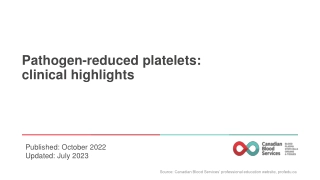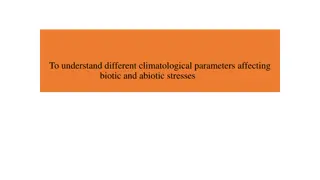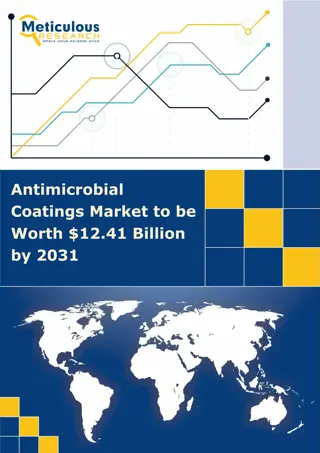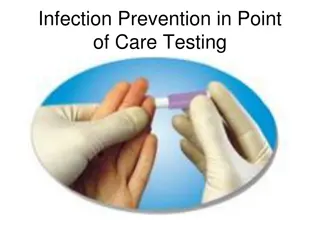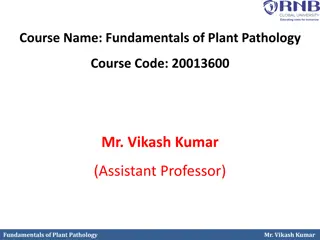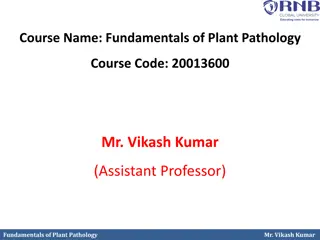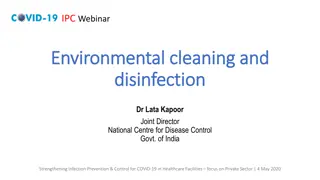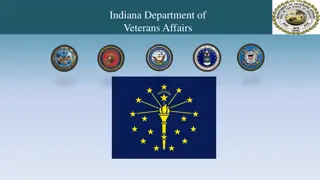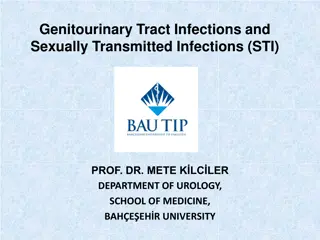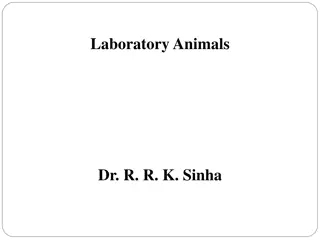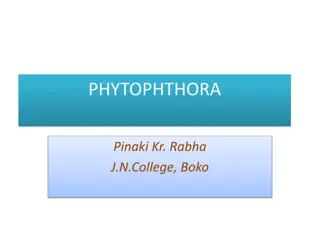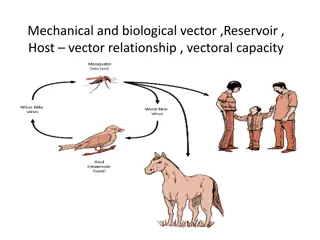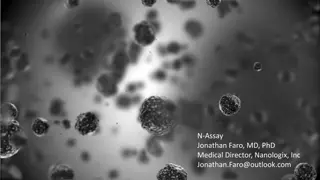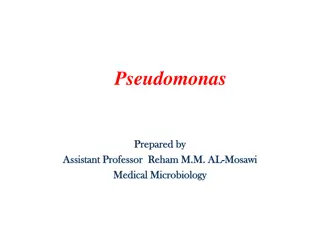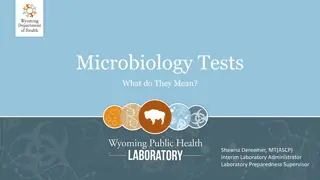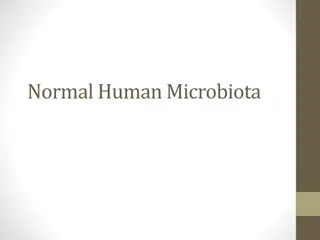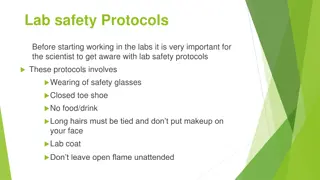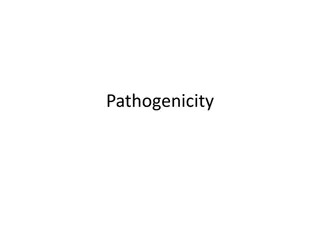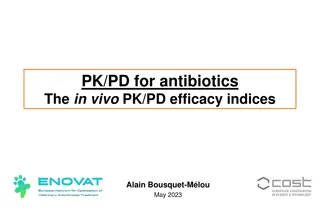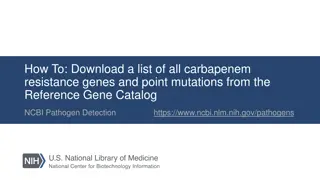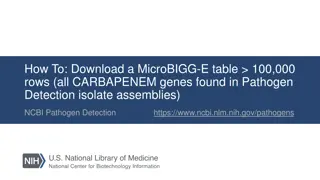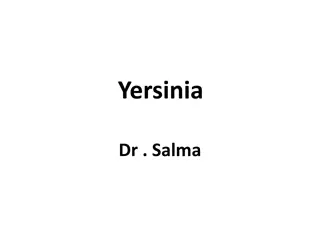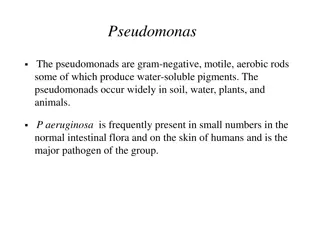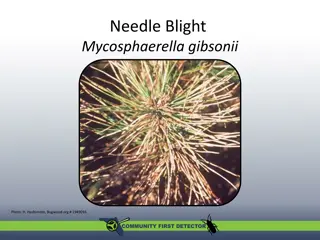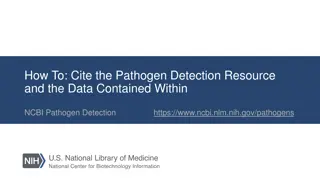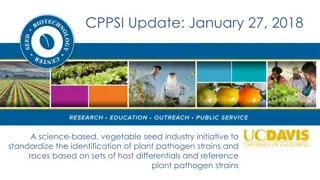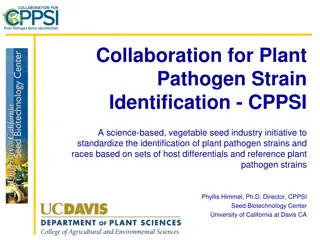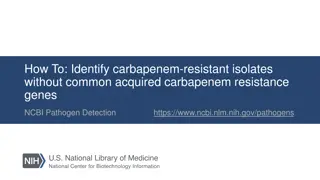Pathogen-reduced platelets: clinical highlights
Pathogen-reduced platelets play a crucial role in reducing the risk of transfusion-transmitted infections through pathogen inactivation technology (PIT). This technology provides an additional layer of safety against various pathogens including viruses, bacteria, protozoa, and leukocytes. Platelet c
2 views • 17 slides
A Scientific Approach to Pandemic Preparedness
Barney S. Graham, MD, PhD, outlines a scientific framework for epidemic and pandemic research preparedness to achieve fast and equitable access to high-quality vaccines for future pandemics. The discussion covers new human viral pathogens, 21st-century viral threats, viral taxonomy, and a prototype
0 views • 16 slides
Update on Pathogen Reduction of Platelets at National Haemovigilance Conference 2023
This update covers the latest developments in pathogen reduction of platelets, including the introduction of whole blood containing platelets. Key strategic initiatives focus on assessing post-collection blood product manipulation processes and developing new products to meet healthcare needs. The a
0 views • 25 slides
CANDIDIASIS
Candidiasis is an opportunistic fungal infection caused by Candida species. Learn about the pathogen, common infections, clinical settings, laboratory diagnosis, and treatment options associated with Candidiasis.
2 views • 33 slides
Understanding Impacts of Combined Stress Conditions on Plant Responses
Environmental stress factors like drought, heat, and pathogen infection can severely affect plant growth. Studies show that plants respond uniquely to combinations of stressors, with complex signaling pathways influencing their reactions. Field conditions differ from controlled lab settings, present
11 views • 5 slides
Antimicrobial Coatings Market: Exploring Sustainable Approaches to Microbial Con
The Antimicrobial Coatings Market is projected to reach $12.41 billion by 2031, at a CAGR of 10.8% from 2024 to 2031. The antimicrobial coatings help to keep surfaces pathogen-free by obstructing the growth of fungi, bacteria, and other parasites. Antimicrobial coatings provide long-lasting protecti
3 views • 4 slides
Understanding Hydroponics: Methods, Advantages, and Crops
Hydroponics, derived from Greek words meaning "working water," is a soilless plant-growing method. It offers various advantages like efficient water use, pesticide-free produce, and higher yields. Different types of hydroponic systems exist, enabling the cultivation of a wide range of crops. However
1 views • 15 slides
Infection Prevention in Point of Care Testing: Equipment and Hygiene Guidelines
This information focuses on infection prevention measures related to point-of-care testing (POCT), particularly concerning shared devices like lancing equipment and glucometers. It highlights the importance of evaluating equipment design, proper hand hygiene practices, and guidelines for using finge
0 views • 9 slides
Understanding Fundamentals of Plant Pathology with Mr. Vikash Kumar
Dive into the world of plant pathology with Mr. Vikash Kumar, an Assistant Professor, as he covers the course objectives, introduction to plant diseases, definitions, scope, responsibilities, and the importance of plant diseases. Learn about identifying diseases, pathogen nature, disease management
0 views • 10 slides
Fundamentals of Plant Pathology with Mr. Vikash Kumar - Course Overview and Important Pathogens
This course with Mr. Vikash Kumar covers the fundamentals of plant pathology, including identification of diseases, pathogen nature, disease management strategies, and principles. Learn about important plant pathogenic organisms such as fungi, bacteria, and fastidious vascular bacteria, along with s
0 views • 12 slides
Best Practices for Environmental Cleaning and Disinfection in Healthcare Settings
Effective environmental cleaning and disinfection are crucial in reducing healthcare-associated infections, especially in the context of COVID-19. This webinar by Dr. Lata Kapoor emphasizes the importance of cleaning high-touch surfaces and implementing established cleaning strategies to remove biob
0 views • 18 slides
Environmental Hazards Faced by Veterans and Agent Orange Exposure Locations
Veterans may have been exposed to a variety of environmental hazards during their military service, including Agent Orange-related diseases, Gulf War illnesses, radiation-related diseases, traumatic brain injury, and more. Agent Orange exposure locations include Vietnam, C-123 airplanes, Blue Water
1 views • 40 slides
Overview of Genitourinary Tract Infections and STIs by Prof. Dr. Mete Kılcıler
Genitourinary Tract Infections and Sexually Transmitted Infections (STIs) are common conditions affecting both men and women. This article, presented by Prof. Dr. Mete Kılcıler from the Department of Urology at Bahçeşehir University School of Medicine, delves into the various aspects of UTIs, in
2 views • 47 slides
Understanding Laboratory Animals and Their Classification
Laboratory animals play a crucial role in scientific research due to their physiological similarity to humans. Common types include mice, rats, hamsters, guinea pigs, rabbits, and monkeys. They are classified into conventional and gnotobiotic animals based on their microbial status. Specific pathoge
1 views • 67 slides
Understanding Ice Hockey Face-Off Locations and Guidelines
Ice hockey face-offs must occur at specific locations marked on the ice, with rules governing where they take place based on various situations like rule infractions or stoppages. This guide covers the basic guidelines for determining face-off locations, including scenarios like intentional offside/
0 views • 12 slides
Understanding Phytophthora: Destructive Plant Pathogen
Phytophthora is a destructive plant pathogen that infects various crops, causing symptoms like leaf lesions and rotting tubers. Its somatic structure includes profusely branched hyphae, and it reproduces asexually through zoospores. The germination process involves the spread of spores by wind and w
1 views • 21 slides
Vector Relationships and Pathogen Transmission
Understanding mechanical and biological vectors, reservoir hosts, and their role in disease transmission is crucial for effective disease control. Mechanical vectors like flies can transfer pathogens without getting infected, while biological vectors like mosquitoes carry pathogens that reproduce in
1 views • 5 slides
Revolutionary N-Assay: Transforming Pathogen Detection in Healthcare
Innovative N-Assay developed by Jonathan Faro, MD, PhD, offers a faster, more accurate, and cost-effective solution for detecting bacterial pathogens in healthcare settings. Unlike traditional assays, N-Assay differentiates between viable and non-viable pathogens, provides information on antibiotic
1 views • 15 slides
Overview of Laboratory Animals and Their Uses in Biomedical Research
Laboratory animals play a crucial role in biomedical research, serving as models for studying various conditions affecting humans and animals. They must thrive in controlled conditions and are used to test hypotheses and drugs. Commonly used lab animals include rodents, lagomorphs, canines, felines,
0 views • 9 slides
Overview of Pseudomonas aeruginosa: Morphology, Identification, and Lab Diagnosis
Pseudomonas aeruginosa is a gram-negative, motile bacterium commonly found in soil, water, plants, and animals. It is a major pathogen known for causing infections in individuals with weakened immune systems. This article delves into the morphology, identification techniques, and lab diagnosis metho
0 views • 7 slides
Understanding Microbiology Testing Methods and Results
Explore the various methods of microbiology testing, learn to interpret microbiological test results, and understand antibiotic susceptibility testing. Discover details on bacterial, viral, and parasitic infections through laboratory reports and supporting results like WBC counts and pathogen identi
0 views • 29 slides
Understanding Salmonella: A Zoonotic Pathogen
Salmonella, a genus of bacteria, includes species causing various diseases in humans, cattle, sheep, goats, and poultry. The pathogen can be transmitted through contaminated food and is classified into typhoidal and nontyphoidal serovars. Nontyphoidal serovars are common and typically lead to self-l
0 views • 20 slides
Understanding Host Defense Mechanisms Against Infection
Host defense mechanisms safeguard the body from pathogens through various strategies such as intact skin, mucous membranes, nonspecific immune responses like phagocytic cells, and specific immune responses involving antibodies and lymphocytes. Key protective barriers include the skin, eyes, digestiv
3 views • 16 slides
Understanding Normal Human Microbiota and Its Role in Health
Normal human microbiota refers to the microorganisms residing on our skin and mucous membranes, playing vital roles in digestion, immunity, and protection against pathogens. They are categorized into resident and transient groups, with resident flora aiding in maintaining health by synthesizing nutr
0 views • 28 slides
Understanding Host-Parasite Relationship in Microbiology
In microbiology, the host-parasite relationship is crucial for understanding diseases caused by pathogens. This lecture covers definitions of terms like pathogenicity, pathogen, disease, resistance, susceptibility, infection, virulence, and transmissibility. It also delves into the division of host
0 views • 16 slides
Laboratory Safety Protocols and Pathogen Classification
Scientist must adhere to lab safety protocols including wearing safety gear, proper waste disposal, and handling chemicals carefully. The classification of pathogens varies by country based on WHO guidelines into four risk groups. Understanding these protocols and classifications is crucial for a sa
0 views • 17 slides
Understanding Pathogenicity in Infectious Diseases and Parasitism
Pathogenicity refers to the ability of a pathogen to cause disease in plants, humans, and animals. Infectious diseases and parasitism play key roles in the spread and development of epidemics. Parasites can hinder the normal growth of plants by extracting nutrients, while different types of parasite
0 views • 5 slides
Understanding PK/PD for Antibiotics: In Vivo Efficacy Indices
This information delves into the PK/PD approach for antibiotics, emphasizing the importance of plasma concentrations in controlling infection site concentrations, details on pathogen locations, binding to plasma proteins, and the significance of tissue concentrations for predicting treatment efficac
1 views • 27 slides
How to Download Carbapenem Resistance Genes from NCBI Reference Gene Catalog
Learn how to download a list of all carbapenem resistance genes and point mutations from the NCBI Reference Gene Catalog for pathogen detection. Follow step-by-step instructions on accessing the catalog, applying filters to select carbapenem subclass, and downloading the data in tab-delimited format
1 views • 7 slides
How to Download a MicroBIGG-E Table with >100,000 Rows from NCBI Pathogen Detection
Learn how to download a MicroBIGG-E table containing all CARBAPENEM genes found in Pathogen Detection isolate assemblies on NCBI. Follow a step-by-step guide to select, filter, and download subsets of data in batches to get the complete dataset.
0 views • 10 slides
Understanding Yersinia Pestis: The Bacterium Behind the Black Death
Yersinia pestis, the causative agent of the infamous Black Death, is a Gram-negative coccobacilli bacterium. It is transmitted through fleas and affects lymph nodes, causing bubonic plague. This article explores its general characteristics, pathogenesis, virulence factors, laboratory diagnosis, and
0 views • 18 slides
Understanding Pseudomonas and Proteus Bacteria
Pseudomonas is a group of gram-negative, motile, and aerobic bacteria found in various environments, with Pseudomonas aeruginosa being a significant pathogen in humans. It can produce distinctive pigments and is resistant to many antimicrobial agents. Lab diagnosis involves culture testing on specif
0 views • 17 slides
Helix Diagnostics: State-of-the-Art Clinical Laboratory in Michigan
Helix Diagnostics, founded in 2015 and located in Waterford Township, Michigan, is a cutting-edge clinical laboratory offering services such as therapeutic drug monitoring, blood chemistry testing, pharmacogenomics, and molecular pathogen detection. With over 125 employees, they serve a wide range o
0 views • 11 slides
Needle Blight Mycosphaerella Gibsonii: Symptoms, Host Plants, and Management
Needle blight caused by the fungal pathogen Mycosphaerella gibsonii is a serious disease affecting various species of Pinus trees. The disease, first recorded in Japan in 1913, primarily impacts seedlings and saplings, leading to significant infection rates and death rates under epidemic conditions.
0 views • 21 slides
How to Cite NCBI Pathogen Detection Resource
Learn how to correctly cite the Pathogen Detection Resource and data within NCBI Pathogen Detection. Follow guidelines on citing the entire resource, subsets of data, accessing Isolates Browser & MicroBIGG-E, using NCBI AMR resources, and acknowledging data submitters in your manuscript.
0 views • 8 slides
Understanding Plant Pathology: Reproduction and Classification of Bacteria
This course on Fundamentals of Plant Pathology, led by Mr. Vikash Kumar, covers essential topics such as disease identification, pathogen nature, disease management strategies, pathogen classification, and plant disease diagnosis. It delves into the reproduction and classification of plant pathogeni
0 views • 16 slides
Standardizing Identification of Plant Pathogen Strains in Vegetable Seed Industry
Focused on standardizing plant pathogen strain identification, the CPPSI initiative by UC Davis works towards enhancing the industry's capabilities. Through reference materials and strategic collaborations, CPPSI aims to streamline disease management processes and promote sustainability. The project
0 views • 8 slides
Collaboration for Plant Pathogen Strain Identification - CPPSI Initiative Overview
CPPSI, a science-based initiative in the vegetable seed industry, aims to standardize plant pathogen strain identification using host differentials and reference strains. The goals include developing differential host sets, enhancing awareness, and facilitating material distribution. Criteria for ex
0 views • 12 slides
Role of Lipids in Plant-Pathogen Interaction
Lipids play a central role in signal molecule production for actively modifying the invasive capabilities of pathogens and the defensive mechanisms of plants during inter and intra-plant-pathogen interactions. They are essential constituents of membranes, providing structural support and serving div
0 views • 43 slides
Comprehensive Guide to Identifying Carbapenem-Resistant Isolates Without Common Acquired Carbapenem Resistance Genes
Utilize the Isolates Browser on NCBI Pathogen Detection platform to search for carbapenem-resistant isolates without common acquired resistance genes. Follow steps such as using AST phenotypes and AMR genotypes, cross-browser selection, and filters to isolate relevant results. Detailed instructions
0 views • 6 slides
